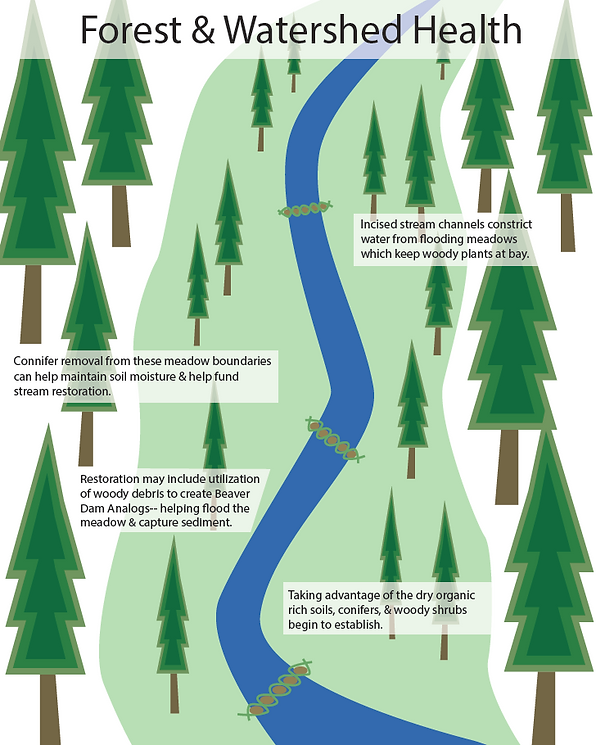
Fall River Resource Conservation District

Watershed Management
Burney Creek Watershed Assessment & Watershed Management Plan
The primary purpose of the Burney Creek Watershed Assessment and Watershed Management Plan is to serve as a guide for the development of ecosystem improvements for the Burney Creek Watershed. This document was developed using available data, previous work by others, and other information available to the FRRCD. The WA/WMP identifies five goals, management objectives for those goals, and management actions to achieve the goals and objectives.
The purpose of the WA/WMP is to:
-
Define conditions limiting or threatening watershed health
-
Define actions needed to address conditions that are currently limiting or threatening watershed health
-
Facilitate a better understanding of causes that are limiting or threatening those conditions
-
Identify lead stakeholders for implementing management actions
-
Identify information needs in the watershed
-
Provide a framework for periodic evaluation of management results, reformulation of management approaches, and identification of new watershed management issues
-
Support the maintenance and improvement of desired landscape conditions in the watershed (e.g. sustainable agricultural operations, open space, quality wildlife habitat)
The five goals discussed in this WA/WMP are:
-
Improve forest health and vigor
-
Improve water quality in Burney Creek
-
Maintain availability of water in the system for irrigation demands and ecological needs
-
Support and encourage better coordination of data collection, sharing, and reporting in the watershed
-
Support community sustainability by strengthening natural-resource-based economies
The Burney Creek Watershed Assessment
The Burney Creek Watershed is located in northeastern California in eastern Shasta County. The major surface water feature draining the watershed is Burney Creek, which flows northward in the watershed and ultimately drains into Lake Britton. The lake is drained by the Pit River, which flows into Shasta Lake, making it part of the Sacramento River Watershed system. The Burney Creek Watershed includes approximately 120,800 acres and 240 stream miles. Elevation in the watershed varies from 8630 feet above mean sea level at the Crater Peak summit, located in the southeastern portion of the watershed, to Lake Britton, located at 2700 feet above mean sea level. The largely volcanic history of the region has done much to shape the topography and landforms present today.
Fall River Watershed Assessment
& Watershed Management Plan
The primary purpose of the Fall River Watershed Assessment and Watershed Management Plan is to serve as a
guide for development of ecosystem improvements for the Fall River Watershed. This document was developed
using available data, previous work by others, and other information available to the FRRCD. The WA/WMP
identifies eight goals, management objectives for those goals, and a strategy that includes management actions to achieve the goals and objectives.
The purpose of the WA/WMP is to:
-
Define conditions limiting or threatening watershed health
-
Define actions needed to address conditions that are currently limiting or threatening watershed health
-
Facilitate a better understanding of causes that are limiting or threatening those conditions
-
Identify lead stakeholders for implementing management actions
-
Identify information needs in the watershed
-
Provide a framework for periodic evaluation of management results, reformulation of management approaches, and identification of new watershed management issues
-
Support the maintenance and improvement of desired landscape conditions in the watershed, (e.g.sustainable agricultural operations, open space, and quality wildlife habitat)
The eight goals discussed in this WA/WMP are:
-
Maintain and restore blue-ribbon trout fishery
-
Improve water quality in the watershed
-
Reduce riverbank erosion
-
Restore riverbed morphology in Fall River
-
Control and prevent spread of invasive species and noxious weeds in the watershed
-
Maintain availability of water in the system for irrigation demands and ecological needs
-
Support and encourage effective coordination of data collection, sharing, and reporting in the watershed
-
Support community sustainability by strengthening natural resource-based economies
Fall River Watershed Assessment
The Fall River Watershed is located in northeastern California and overlaps into Lassen, Modoc, Siskiyou, and
Shasta Counties. Fall River flows west through the watershed and drains into the Pit River and eventually into Lake
Shasta. The Fall River Watershed includes approximately 203,000 acres and 340 stream miles. Elevation in the
watershed varies from 6321 feet above mean sea level (MSL) at the Widow Mountain summit located in the eastern portion of the watershed to the Fall River Valley located at 3200 feet above MSL. The largely volcanic history of the region has done much to shape the topography and landforms present today.
Hat Creek Watershed Assessment
& Watershed Management Plan
The primary purpose of the Hat Creek Watershed Assessment (WA) and Watershed Management Plan (WMP) is to serve as a guide for the development of ecosystem improvements for the Hat Creek Watershed. This document was developed using available data, previous work by others, and other information available to the FRRCD. The WA/WMP identifies seven goals, management objectives for those goals, and management actions to achieve the goals and objectives.
The purpose of the WA/WMP is to:
-
Define conditions limiting or threatening watershed health
-
Define actions needed to address conditions that are currently limiting or threatening watershed health
-
Facilitate a better understanding of causes that are limiting or threatening those conditions
-
Identify lead stakeholders for implementing management actions
-
Identify information needs in the watershed
-
Provide a framework for periodic evaluation of management results, reformulation of management
approaches, and identification of new watershed management issues
-
Support the maintenance and improvement of desired landscape conditions in the watershed (e.g.
sustainable agricultural operations, open space, quality wildlife habitat)
The six goals discussed in this WA/WMP are:
-
Support community sustainability by strengthening natural-resource-based economies
-
Maintain high-quality water in Hat Creek
-
Maintain and improve forest health and vigor
-
Maintain availability of water in the system for irrigation demands and ecological needs
-
Maintain and improve habitat quality for indigenous cold water fish
-
Support and encourage better coordination of data collection, sharing, and reporting in the watershed
Hat Creek Watershed Assessment
The Hat Creek Watershed is located in northeastern California in Shasta and Lassen Counties. Hat Creek flows
north through the watershed and drains into the Pit River. The Hat Creek Watershed includes approximately 243,000 acres with 250 stream miles. Elevation in the watershed varies from 10457 feet above mean sea level at the Lassen Peak summit, located in the southern portion of the watershed, to the confluence with the Pit River at 2800 feet above mean sea level. The largely volcanic history of the region has done much to shape the topography and landforms present today. The Hat Creek Watershed is known for its cool, clear water and blue-ribbon wild trout. The watershed is in healthy condition today, with the exception of fuel-loading on USFS land. As long as landowners continue to keep the working landscapes in the watershed viable, and economic conditions
and landscape uses improve, the health of the watershed will be maintained for years to come.
